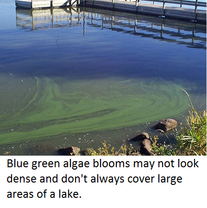 St. Paul, Minn.-- Temperatures are going
up, and in Minnesota, many of us are cooling down at our favorite lakes. However,
high temperatures combined with rainfall can create the conditions for harmful
blue-green algae. This type of algae can harm pets, livestock, and even people.
In late June a child
was hospitalized after being exposed to blue-green algae while swimming in
Alexandria’s Lake Henry. Earlier in June, multiple dogs were sickened, and two
dogs died from exposure to toxic blue-green algae in Red Rock Lake, located in
Douglas County. While both of these instances occurred in the Alexandria area,
blue-green algae blooms can impact lake waters throughout Minnesota.
The key to solving
algae problems is to improve overall water quality by reducing how much
phosphorus gets into lakes from urban and agricultural runoff and wastewater
treatment systems.
What’s the risk?
The unpleasant odor
and appearance of a blue-green algal bloom typically keeps most people out of
the water. However, people can become sick after they swim, boat, waterski, or
bathe in water that has a toxic blue-green algal bloom. During these activities
people are exposed to the toxins by swallowing, having skin contact with, or
breathing in airborne droplets of water. If someone becomes sick, symptoms may
include vomiting, diarrhea, rash, eye irritation, cough, sore throat, and
headache.
Dogs are at particular
risk as they wade in shoreline areas where algae may accumulate. Dogs exposed
to blue-green algae can experience symptoms such as vomiting, diarrhea, rash,
difficulty breathing, general weakness, liver failure, and seizures.
If you or your pets
experience any of the above symptoms after visiting a lake, seek medical or
veterinary assistance immediately.
Some safety tips for you
Not all blue-green
algae are toxic, but there is no visual way to predict whether a blue-green
algal bloom contains toxins and is harmful to humans or animals. Harmful blooms
often look like pea soup, green paint, or floating mats of scum, and sometimes
have a bad odor. Blue-green algae may not look dense, and it doesn't always cover large areas of a lake. If algae is present in the water, toxic conditions can occur even without obvious signs of scum.
“If it looks and smells
bad, don’t take a chance. We usually tell people, if in doubt, stay out,” said
Pam Anderson, MPCA Water Quality Monitoring Supervisor. “If you’re not sure,
it’s best for people and pets to stay out of the water.” Don’t swallow, swim,
or wade in water with blue-green algae. If you come into contact with
blue-green algae, or if it gets on your skin, thoroughly wash it off, paying
special attention to the swimsuit area. If you think your dog swam in water
where blue-green algae were present, rinse them off with fresh water
immediately.
|